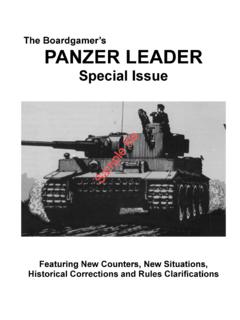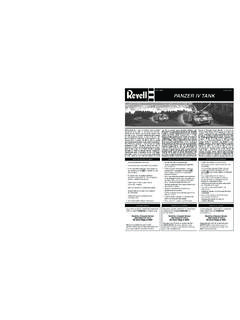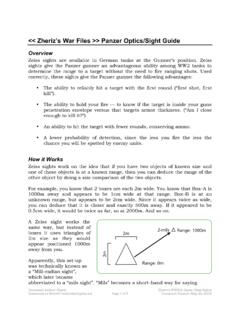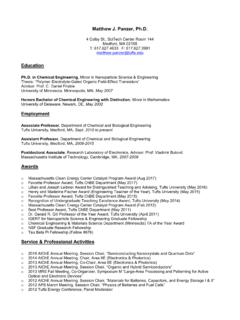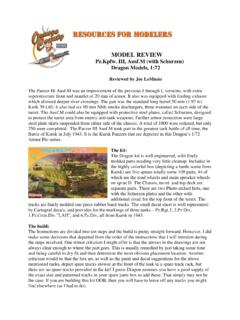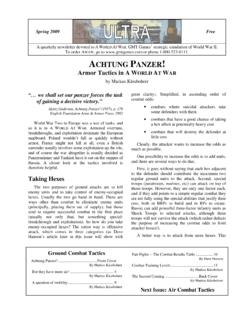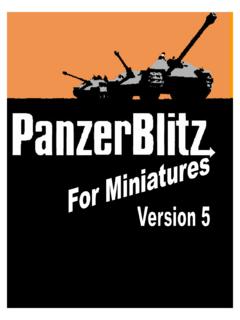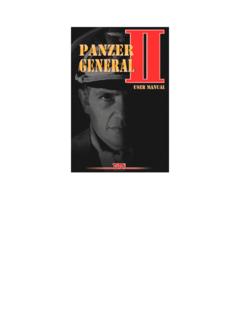Transcription of Spanish Panzer IV - All Empires: Online History Community
1 Spanish Panzer IV By Catalan 15 January 2008; Revised Category: 20th Century: Military History The end of the Spanish Civil War in 1939 saw a drastic modernization of Spain s armored forces. Of course, the word modernization can only be used when comparing Spain s armor prior to the war with what it was left at the war s end. Spain purchased her first tank on 19 May 1919 from the French Renault factory. This tank was the French FT-17, designed during the First World War, and the tank represented a fairly important step in the mechanization of the Spanish Army. Despite Spanish interests in acquiring at least another ten vehicles, the French government was unwilling to complete further orders.
2 It wasn t until the Spanish colonial disaster at the Battle of Annual that the French government finally conceded to the sale of another eleven FT-17s, including one command tank. These twelve tanks served in the Spanish Protectorate of Northern Morocco between 1922 and 1926, partaking in the amphibious landing at Alhucemas in September 1925. When the Spanish Civil War began in July 1936, two small regiments were outfitted with a total of ten FT-17 tanks both the Republic and the Nationalist uprising were able to gain control of one of these regiments a piece[1]. For all intents and purposes, the Spanish Civil War began with ten obsolete FT-17s and six CA1 Schneider tanks of the same era.
3 The CA1s had been sold by the French government to Spain in the same deal as the FT-17s, and also served during the Rif War in Morocco[2]. By the end of the war, the victorious Nationalist Front under the leadership of Francisco Franco found itself in possession of a large fleet of German supplied Panzer I light tanks, Italian L-3-35 tankettes and over one hundred captured Soviet T-26s. Although this material was considerably superior to the ten FT-17s which found themselves in working condition in July 1936, it was already obsolete when compared to contemporaneous equipment in use by the belligerent nations of the Second World War.
4 In fact, the Germans had negated to supply Spain with the most advanced tanks available to them at the time. Understandably, production did not allow for the employment of newer models of armored fighting vehicles in Spain between 1936 and 1939, but the fact that newer tanks were already in existence during the Spanish Civil War only serves to underscore the point that Spanish armor was severely antiquated in face of potential future threats. For example, as Germany supplied the Nationalist Front with Panzer Is, they already began the production of the Panzer III Ausf A. In comparison to the pair of MG13 light machine guns which armed each Panzer I,[3] early model Panzer IIIs were armed with the superior 37mm L/45 canon[4].
5 The heaviest tank gun in the Spanish arsenal was the T-26s 45mm high velocity cannons and these couldn t compare to the more potent guns being unveiled by the Germans[5] and Soviets. In fact, Nationalist Panzer Is and L-3-35s were found to be worthless against Republican T-26s and BT-5s. During fighting in the approaches to Madrid in 1936, the machine guns mounted on the two fascist light tanks were too weak to penetrate the 15mm steel armor on the T-26.[6] The immediate Spanish response was to begin a modernization program of her Panzer Is during the war, culminating in a short-lived attempt to rearm a number of Panzer Is with the Italian 20mm Breda model 1935 anti-air cannon.
6 With a penetration of 40mm, it was considered that the 140 gram armor piercing projectile and the gun were sufficient to defeat Soviet armor used by the Republicans. However, only four were transformed and subsequent attempts to mount 37mm and even 45mm anti-tank guns on the Panzer I failed before the physical work was even attempted.[7] In the end, the Nationalist army pressed into service captured T-26 to even the odds against their opponents. So important did the T-26s become that German general von Thoma offered 500 pesetas for each captured T-26[8]! In the immediate post-war, Spanish attempts at the production of an indigenous tank also failed.
7 Although production of Spain s Verdeja light tank was ordered to begin as early as January 1939 production as soon as the vehicle was completely completed in the prototype stage , production of this tank ultimately faltered due to the lack of a dedicated engine and the adequate type of steel. Nevertheless, the Verdeja deserves mention due to the amount of innovation represented by the project. In some ways, the Verdeja was too advanced for its age and highly unorthodox. For example, it is one of the first tanks to position the engine at the front of the hull to increase protection for the crew.
8 This feature was unseen in any other tank thereafter until the advent of the Israeli Merkava in 1939. The Verdeja mounted a captured 45mm tank gun and originally used a 120mm Ford Zephyr gasoline engine. Perhaps one of the most innovative features was the new track system, designed to avoid derailments the roadwheels were positioned within a centerline groove within the track. Unfortunately, although the Verdeja was found to be completely superior to the T-26, the project faltered in the face of the lack of enough steel for vehicle construction[9]. The singular Verdeja 1 prototype was later converted into a 75mm self-propelled artillery piece a project which also failed , which can be seen today at the tank museum of El Goloso.
9 Another prototype, this time of the future Verdeja 2 project, can be found at the Infantry Academy at Toledo the Verdeja 2 was also never put into production. By the early 1940s Spain found herself with an ageing tank fleet composed of armor a decade old and further degrading in usefulness in the face of the quick pace of armor development during the Second World War. In March 1943, Spanish representative General of the Artillery Carlos Mart nez Campos began negotiating with the German government for the acquisition of German armor. In specific, the Spanish Army was looking to procure two hundred and fifty tanks armed with either a 45 or 50mm cannon, which may have corresponded to the latest versions of the Panzer III, and one hundred tanks armed with 75mm cannons, which were the Panzer IVs[10].
10 The two hundred and fifty tanks with 50mm cannons were to replace Spanish Panzer Is and L-3-35s, while the Panzer IVs were destined to replace the T-26. By 1943 Daimler-Benz was producing the Panzer III Ausf L with the 50mm L/60 high velocity anti-tank cannon and an armor protection of 57mm on the turret[11]! Unfortunately, ultimately the German government decided to agree to a sale of only twenty Panzer IV Ausf Hs and ten StuG III Ausf Gs, which were supplied to Spain by December 1943. This sale represented only a fifth of the original order for Panzer IVs, and none of the order for the lighter Panzer III.
